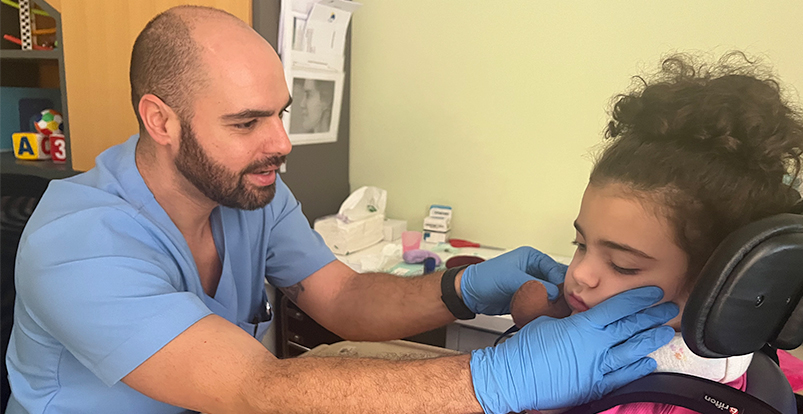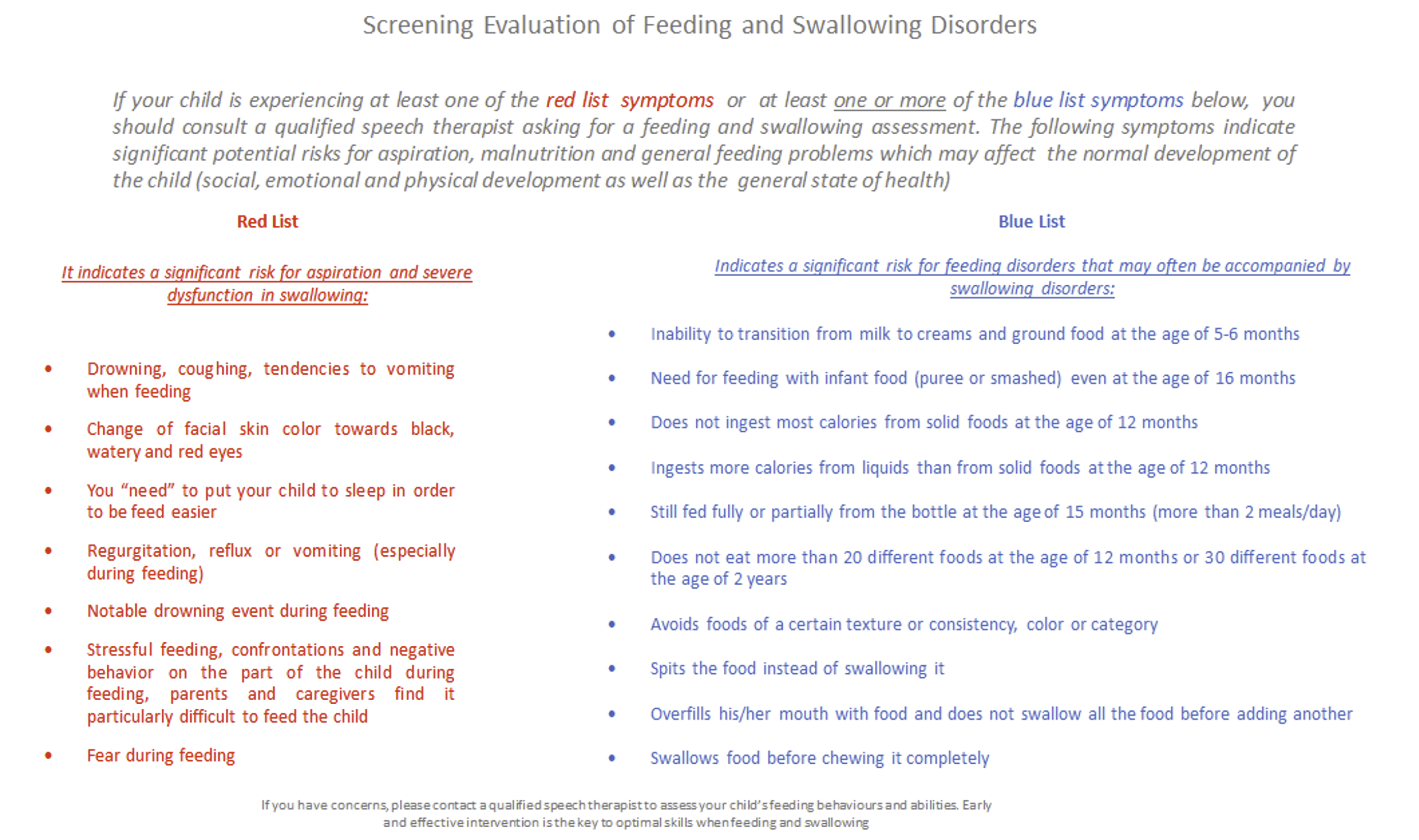
What happens when my kid swallows?
Swallowing is divided into three stages. The first stage, the oral–preparatory, is a voluntary process hosted in the oral cavity, where biting, chewing and mixing of food with saliva occur. The resulting food particles are termed bolus. Additionally, at this stage, the child can suck and drink liquids through a straw or a cup.
The second stage, the pharyngeal, is an involuntary process where the bolus passes from the mouth to the esophagus through the larynx. The airway and lungs are protected during swallowing because of the larynx’s proper function. If an amount of food passes through the larynx to the trachea and not to the esophagus, then the lungs can be infected, leading to aspiration pneumonia.
The third stage, the oesophageal, is responsible for passing involuntarily the bolus through the esophagus to the stomach and starting digestion.
How do I know if my child is swallowing smoothly?
Disruptions in the above-mentioned stages and functions may result from mild to severe swallowing disorders, with various underlying deficits. The symptoms vary depending on the severity of the underlying disorder and the age of the child.
The most frequent symptoms are:
- Difficulty chewing foods
- Difficulty initiating swallowing
- Difficulty managing oral secretions
- Coughing and/or choking during or after swallowing
- Loss of food/liquid from the mouth when eating
- Breathing difficulties during feeding (tachypnea, cyanosis, apnea etc)
- Noisy breathing
- “Gurgly” voice during or after eating or drinking
- Frequent chest infections (aspiration pneumonia)
Swallowing disorders could result in:
- Feeding aversion
- Malnutrition, low vitamin intake
- Dehydration
- Poor weight gain
- Constipation or other gastrointestinal complications
- Aspiration pneumonia
- Interventions such as nasogastric tube or gastrostomy tube feeding
- Psychosocial effects on the child and their family
What are the reasons underlying swallowing difficulties?
There are different etiologies that could lead to swallowing difficulties. Some of them are presented below:
- Neurological disorders (e.g. for children with cerebral palsy is estimated to be 19.2%–99.0%)
- Complex medical conditions (e.g., pulmonary disease, gastroesophageal reflux disease [GERD], allergies, heart disease)
- Factors affecting neuromuscular coordination (e.g., prematurity, low birth weight, hypotonia, hypertonia)
- Structural abnormalities of the swallowing mechanism (e.g. for children with craniofacial disorders are estimated to be 33%–83%)
- Genetic conditions
- Developmental disorder (e.g. for children with Autism Spectrum Disorder is 2-5 times more frequent than in typical development)
- Medication side effects (e.g., lethargy, decreased appetite)
Who do I need to consult if my child has swallowing difficulties?
A speech-language therapist (SLT) specializing in swallowing disorders is responsible for the assessment, diagnosis, and treatment of swallowing disorders. The therapist will collaborate with a multidisciplinary team comprising physicians from different fields—including pediatrics and neurology—clinical nutritionists, and other professionals to plan and deliver personalised treatment for children with swallowing disorders.
What are the steps of a valid swallowing evaluation?
Both clinical and instrumental evaluations are extremely important and should be done to determine the presence or the absence of a swallowing disorder.
Clinical evaluation
At the clinical evaluation, the SLT first inquires about the child’s medical and social history to collect valuable information about the child’s feeding skills and difficulties.
Thereafter, the SLT should assess the oral and motor structures and functions by performing stimulation and a variety of exercises on the oral structures. Observation and involvement during mealtime enable the clinician to understand the child’s strong and weak points. Families are encouraged to bring food and drink common to their household and utensils typically used by the child. If the clinician needs more information about the function and the structure of the swallowing mechanism, she/he will refer to instrumental evaluations of swallowing.
Instrumental evaluation
The two instrumental evaluations that are most used are:
- Videofluoroscopic Swallowing Study (VFSS), conducted in collaboration with a radiologist); and,
- Flexible Endoscopic Evaluation of Swallowing (FEES), conducted in collaboration with an ENT physician.
Instrumental evaluation is the key process that provides the clinician with information on the structure and function of the swallowing mechanism, complementing the clinical assessment.
Based on the outcomes of the instrumental evaluation, the clinician can devise a treatment plan that targets the child’s weaknesses to improve their swallowing function and make oral feeding safer for them. Moreover, the SLT will be able to specify the safest texture and consistency as well as quantity of solid and liquid foods for the child, and define the optimal eating position.
In case you are concerned about your child’s swallowing, please fill out the below Screening Evaluation of Feeding and Swallowing Disorders and schedule a consultation with our feeding specialist.

Sources:
- Costa A, Martin A, Arreola V, Riera SA, Pizarro A, Carol C, Serras L, Clavé P. Assessment of Swallowing Disorders, Nutritional and Hydration Status, and Oral Hygiene in Students with Severe Neurological Disabilities Including Cerebral Palsy. Nutrients. 2021 Jul 14;13(7):2413. doi: 10.3390/nu13072413. PMID: 34371923; PMCID: PMC8308512.
- Calis EA, Veugelers R, Sheppard JJ, Tibboel D, Evenhuis HM, Penning C. Dysphagia in children with severe generalized cerebral palsy and intellectual disability. Dev Med Child Neurol. 2008 Aug;50(8):625-30. doi: 10.1111/j.1469-8749.2008.03047.x. PMID: 18754902.
- DeMatteo C, Matovich D, Hjartarson A. Comparison of clinical and videofluoroscopic evaluation of children with feeding and swallowing difficulties. Dev Med Child Neurol. 2005 Mar;47(3):149-57. doi: 10.1017/s0012162205000289. PMID: 15739718.
- Dodrill P, Gosa MM. Pediatric Dysphagia: Physiology, Assessment, and Management. Ann Nutr Metab. 2015;66 Suppl 5:24-31. doi: 10.1159/000381372. Epub 2015 Jul 24. PMID: 26226994.





